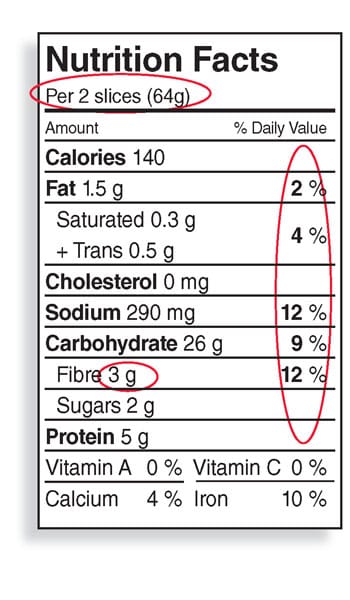Making healthy choices in the grocery store can be an overwhelming process-especially when it comes to making sense of food labels. It can be a challenge to understand what nutritional labels are telling you-and what's really behind the health claims on some packaging. If you're confused, you're certainly not alone.
All food products in Canada require a nutritional label, with the following exceptions: spices, herbs, fresh vegetables and fruits, raw meat, poultry, fish and seafood, foods prepared or processed at the store and items with minimal nutrients such as alcoholic beverages.

What you need to know to make sense of nutrition labels.
Making healthy choices in the grocery store can be an overwhelming process-especially when it comes to making sense of food labels. It can be a challenge to understand what nutritional labels are telling you-and what's really behind the health claims on some packaging. If you're confused, you're certainly not alone.
All food products in Canada require a nutritional label, with the following exceptions: spices, herbs, fresh vegetables and fruits, raw meat, poultry, fish and seafood, foods prepared or processed at the store and items with minimal nutrients such as alcoholic beverages.
Nutritional labels can help consumers control their intake of specific nutrients and allow them to compare the composition of various products. All labels list calories and 13 core nutrients: fat, saturated fat, trans fat, cholesterol, sodium, carbohydrate, fibre, sugars, protein, vitamins A and C, calcium and iron.
Consider the label shown on the next page, which lists the nutritional information for whole wheat bread.
The first thing to look at is the serving size. Is it realistic? Ask yourself if you would eat more or less than this, and calculate nutrient content accordingly. The serving size is also helpful when comparing products; keep in mind that serving sizes for similar products are not always the same. Also consider the volume versus the weight of the product-a serving for cereal A may be ½ cup and for cereal B, ¼ cup. If they both weigh 28 g, they can be directly compared.
The numbers immediately after the nutrients, measured in grams or milligrams, are the actual amounts found in the food. Referring to the label at right, a two-slice serving (64 g) provides 3 g fibre, 140 calories and 1.5 g fat. These numbers are not always helpful when considering nutritional value, because most people don't know their daily target amounts for each nutrient.
The "% Daily Value" (% DV) allows consumers to determine whether the item is high or low in a particular aspect. The Daily Values for vitamins and minerals are based on the highest recommended intakes for most people, but keep in mind that we all have different needs. The general rule is that a % DV of 5 per cent or less means that a product is low in that particular nutrient (except fibre, where 16% is considered high). A value of 15 per cent or higher means that the product is high in that nutrient. You should aim low for total fat, saturated and trans fats, cholesterol and sodium. Aim high for fibre, vitamins A and C and minerals (calcium & iron).
Informed grocery shopping may take a little time but once you're familiar with the product labels, you'll be able to shop confidently, knowing that you're making the right food choices for you and your family.
